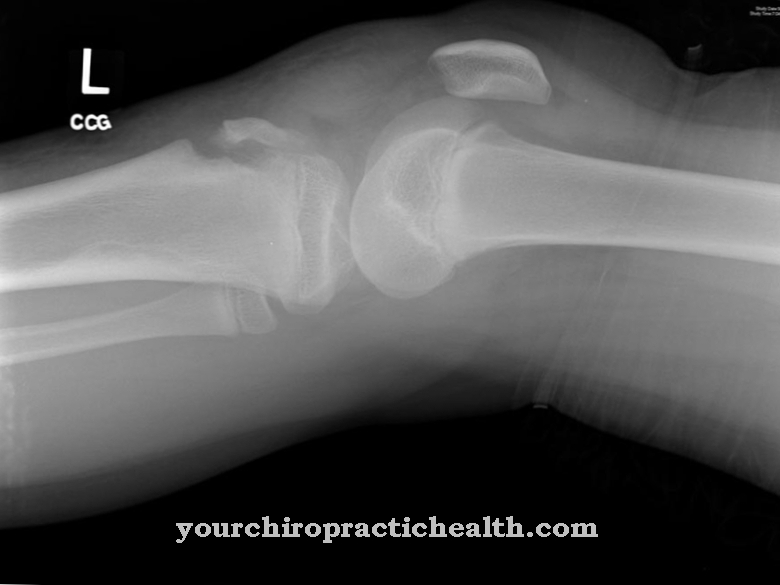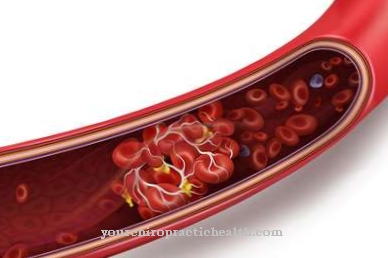Of the Ureteral stone is a deposit in the ureter. In most cases, a ureteral stone comes off on its own.
What is a ureteral stone?

© Henrie - stock.adobe.com
In medicine, the ureteral stone is also called Ureteral stone designated. Ureter stones are so-called concrements, i.e. solid masses that can be deposited in a hollow organ such as the ureter, for example.
Such a calculus is called a ureteral stone, among other things, because it looks like a stone. Depending on the number and severity of ureteral stones and their location, the deposits in the ureter can cause mild to colic pain.
Since the ureteral stone can damage the urethral mucosa, in some cases slight bleeding occurs, which can be detected in the urine. The ureteral stone occurs equally often in women and men. The risk of developing ureteral stones increases with age.
causes
A ureteral stone is often caused by too concentrated urine or by too high a concentration of certain substances in the body. Corresponding substances cannot dissolve in the urine and crystals form - like the ureteral stone.
Possible causes of an increased concentration of various substances and a subsequent ureteral stone are, for example, one-sided nutrition and / or existing metabolic diseases. The use of various medications can also promote the appearance of ureteral stones.
Furthermore, a ureteral stone can be favored by existing inflammation of the urinary organs. Since the body of a healthy person produces substances that inhibit the development of a ureteral stone, another possible cause of calculus formation is a deficiency of the body's own substances.
However, the underlying causes of a ureteral stone cannot always be clearly clarified.
Symptoms, ailments & signs
Ureteral stones can cause a wide variety of complaints. This means that ureteral stones can remain completely symptom-free over a long period of time.Sometimes a laboratory test of the urine shows traces of blood, but these were not visible to the naked eye to those affected. Blood in the urine, visible and invisible, can be the first indication of a ureteral stone, because depending on its location and size, this can cause injuries to the mucous membranes.
However, ureteral stones can also cause severe pain that requires immediate examination and treatment. This is especially the case when the ureteral stone starts to move and, for example, pushes itself across the ureter. A complete or partial prevention of the flow of urine would result, which can lead to internal poisoning.
A cross-seated stone, which closes the ureter, causes severe pain even in those affected. The pain is usually described as colicky and of almost unbearable intensity. Evidence of a ureteral stone is sometimes found incidentally on ultrasound.
Depending on the size and location, further treatment must be discussed with a specialist, because large stones in particular can lead to colic. Small ureteral stones, which do not cause any discomfort to the person concerned, often go away by themselves and can often be waited for under medical supervision without treatment.
Diagnosis & course
In order to diagnose a ureteral stone and its causes, a patient consultation usually takes place first. In this conversation, the attending doctor asks, for example, symptoms of a patient; You can ask about a red color of the urine and / or a ureteral stone that has occurred in the past.
Asking the medical history is usually followed by a physical examination. In addition to blood and urine tests, X-rays or ultrasound images can be made that depict a ureteral stone.
If there is a ureteral stone, the course of the disease depends, among other things, on the size and position of the stone; For example, smaller stones can come off by themselves after a while with the help of supportive measures (such as drinking enough). If this does not happen, various therapeutic measures may be necessary.
A urinary tract infection is one of the possible complications in connection with a urinary ladder stone; Corresponding pathogens can spread from here to the kidneys and / or blood. If the urine backs up into the kidney with a very large urine ladder stone, this can lead to severe kidney damage.
Complications
A ureteral stone blocks the urine exits, which can build up as a result. This increases the risk of the urinary tract or the kidney becoming inflamed. In the worst case, the inflammation can spread systemically over the entire body and thus lead to sepsis. This can lead to multiple organ failure.
Furthermore, the urine can build up up to the kidneys, which can expand as a result and thus lead to a water sac kidney (hydronephrosis). In the course of this, the kidney can fail as a result (renal insufficiency), so that the quality of life of the person concerned is severely impaired. The kidneys have problems excreting enough acids so that these accumulate in the body and over-acidify it.
The potassium ions are also no longer adequately excreted, which also accumulate and thus lead to cardiac arrhythmias. In addition, not enough water is excreted. This remains in the blood and the heart has to do more work, the blood pressure rises. Over the years, this can result in atherosclerosis. Edema is also increasingly observed, as more water is pressed from the blood into the tissue.
In the worst cases, the kidney can no longer contribute to the patient's life support, so that the patient has to undergo dialysis or a new kidney has to be transplanted.
When should you go to the doctor?
Since a ureteral stone is usually associated with severe pain and other unpleasant symptoms, a doctor should always be consulted. A visit to the doctor is necessary if the patient experiences severe pain while urinating.
These pains are burning or stabbing and can have a very negative impact on the person's quality of life. Pain in the kidneys or flanks can also indicate a ureteral stone and should be examined. Often there is also a red coloration of the urine due to blood.
Nausea can also indicate a ureteral stone and should always be examined if it occurs with painful urination. If the ureteral stone is not treated, in the worst case scenario it can lead to kidney damage.
A ureteral stone is treated by a urologist. An early diagnosis can quickly lead to a positive course of the disease without complications. In severe cases or in the case of very severe pain, the hospital can also be visited.
Doctors & therapists in your area
Treatment & Therapy
Colic pain associated with a ureteral stone can be treated symptomatically with pain reliever or anticonvulsant drugs; such pain relievers can be injected into a person's vein, for example.
If a ureteral stone does not go away by itself or with the help of the supply of large amounts of fluid, special medication can lead to a loss of the stone in some cases. Further therapy options are to smash a large ureteral stone using various methods.
The resulting smaller pieces of the ureteral stone then usually come off independently. In the case of a ureteral stone that is no larger than approx. 2.5 centimeters, a corresponding external fragmentation can usually be carried out using ultrasound waves.
If this procedure is not possible, various other methods of breaking up are available, in which devices are inserted into the ureter.
If these procedures remain successful or if they are not possible, a final step in therapy is to remove the ureteral stone with the help of a surgical procedure.
Outlook & forecast
The prognosis of a ureteral stone is favorable. Spontaneous healing can be documented in most patients, as the substances that have settled in the body dissolve and are removed by themselves. Treatment is not always necessary due to the possibility described. The targeted supply of fluids can already dissolve a ureteral stone and thus initiate recovery.
The deposited crystals can develop into different sizes. These are responsible for the occurrence of possible complications. In severe cases, pain and inflammation occur. If the patient has a weakened immune system, healing may be delayed. The inflammation can spread and cause deterioration in general health.
Medical care is necessary so that the organism can provide sufficient defenses. In rare cases, surgery is necessary. The ureteral stone is completely removed and the patient is then released from the treatment as healed.
A new formation of the ureteral stone is possible in the course of life. People with an unhealthy lifestyle are particularly at risk. If the symptoms recur, the prognosis remains good. The sooner the foreign body is noticed, the less risky are the options for removing it. In the long term, however, a change in eating habits is recommended to avoid a relapse.
prevention
In order to prevent a ureteral stone, doctors first recommend general preventive options such as drinking sufficient amounts of fluids (approx. 2 to 4 liters per day) and a diet that is not too salty. Since there are more ureter stones in overweight people, preventive weight reduction can be useful. If medically sensible, a ureteral stone can also be prevented with medication.
Aftercare
After the urinary stones have been eliminated, individual follow-up measures must be decided. Urinary stones recur in around 50 to 70 percent of cases. Regular medical follow-ups are therefore necessary. As part of the check-up, the doctor will carry out a metabolic diagnosis, including taking urine and performing a physical examination.
In the case of chronic ailments, a ureteral stone that has been eliminated can be used for analysis. A stone analysis and other basic diagnostic measures will determine any health problems. Typical urine diagnostics are carried out using a urine test strip. The doctor checks the cystine, uric acid and struvi levels, among other things.
If there are deviations from the norm, medication can be prescribed to prevent the formation of another ureteral stone. If the outcome is positive without chronic ailments, the frequency of follow-up examinations can be reduced. If chronic metabolic disorders are present, a monthly frequency is advisable. The first follow-up check takes place no earlier than four weeks after the initial treatment of the stone disease.
An earlier study only provides information about the immediate development after therapy, but not about the long-term prospects. If necessary, the patient should consult other medical professionals as part of the follow-up care. Follow-up care is provided by your family doctor or a urologist. In the case of chronic illnesses, the relevant specialist must also be involved in the follow-up examinations.
You can do that yourself
Ureteral stones should always be treated by a doctor. Various home remedies and self-help measures are available to accompany medical treatment. Those affected should first drink enough - at least three liters per day - and exercise a lot. The stone can usually be quickly loosened and rinsed out through physical activity and physiotherapy. Climbing stairs regularly is a particularly effective measure for ureteral or kidney stones.
If this does not work, foods and dietary supplements with a lot of magnesium may help. An alternative natural remedy is dandelion. Taken in the form of tea, the diuretic supports the removal of ureteral stones and also promotes blood flow to the kidneys. A low-meat and low-fat diet should also be observed.
Calcium in particular, which is contained in milk and milk products, should be avoided in acute ureteral stones. Likewise, rhubarb, chard, spinach and other foods with oxalic acid as well as foods that are too sugary and salty.
If these measures do not have any effect, you should consult a doctor and have the stones medically treated. Classic painkillers such as ibuprofen or metamizole, but also natural painkillers from nature, help against the pain.













.jpg)

.jpg)
.jpg)











.jpg)